With the improvement of people's living standards and the continuous development of technology, 4K ultra-clear television has become the mainstream of the market. As we all know, the resolution of 4K TV reaches 3840×2160, which is 4 times of the resolution of full HD TV screen (1920×1080) and 8 times of HDTV screen resolution (1280×720). In theory, 4K TV can provide users with unprecedented delicate images and show more detailed images. However, many businesses now use the banner name of 4K. However, the products introduced do not meet the 4K standard. We all call it pseudo 4K and fake 4K.
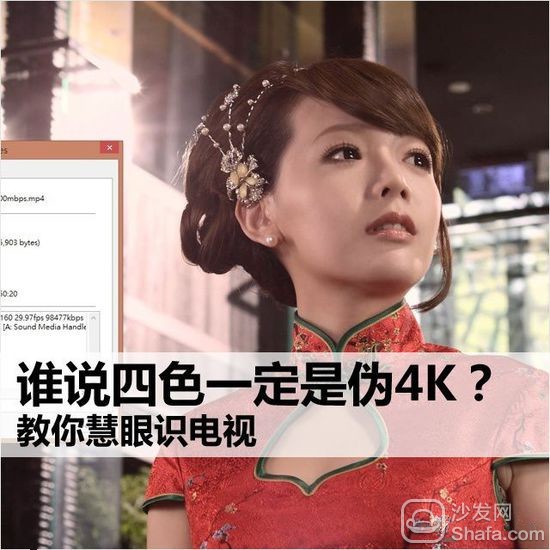
Strictly speaking, the real 4K TV should have three conditions: First, the TV screen must be 4K; Second, the TV should configure the HDMI2.0 interface, can receive and download 4K resources; third, 4K TV must also There are 4K decoder chips. For the HDMI2.0 interface and 4K decoder chip, its classification is simple, consumers are more easily distinguished. But for the screen, various manufacturers have different standards and names, and consumers often do not know exactly which is the real 4K.
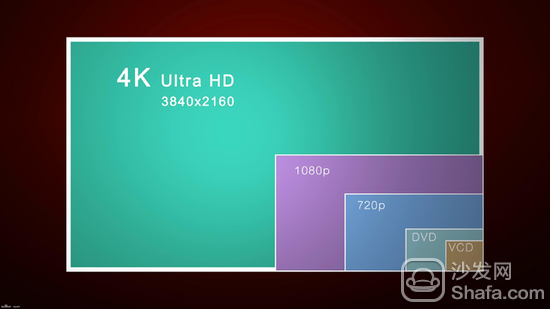

RGBW vs. RGB

In order to control costs and improve the brightness of the screen, some manufacturers have to sacrifice costs properly. While increasing white sub-pixels, the number of sub-pixels that make up a complete pixel is reduced. For example, originally composed of 3 sub-pixels constitutes a pixel, which is now changed to 2 or 2.5 sub-pixels, and the color is displayed by the color proportions of the 2 or 2.5 sub-pixels. Less than three sub-pixels cannot display rich colors, so its display also requires the cooperation between adjacent pixels. The fineness of the final picture will surely be discounted to a certain extent, and it will not be able to achieve true 4K results.
Speaking so much of the theory, though, has generally explained the relationship between four-color technology and 4K. However, if it is not combined with an example, it would be difficult to understand. Below, the author will analyze it according to the mainstream four-color technology classification.
Pseudo 4K RGBW four-color high-brightness and energy-saving
Pseudo 4K RGBW four colors
In fact, there are two very confusing names in the four-color technology, namely RGBW and WRGB. RGBW 4K panel is a type that Samsung, LGD and other manufacturers have introduced, and it is a pseudo 4K. And WRGB is the unique technology of LG OLED TV, it is true 4K. We are talking about RGBW four-color 4K technology below.

Two well-known Korean corporate brands launched two RGBW solutions. A scheme launched by Samsung is called "Green UHD," and each pixel consists of two sub-pixels (RG or BW). According to its calculation method, since two sub-pixels can constitute one pixel, the resolution can reach 3840×2160. But if the RGBW is one pixel unit, its resolution is only 1920×2160. And the total number of sub-pixels is only 1920×2160×4, and the total number of sub-pixels of RGB 4K is 3840×2160×3.
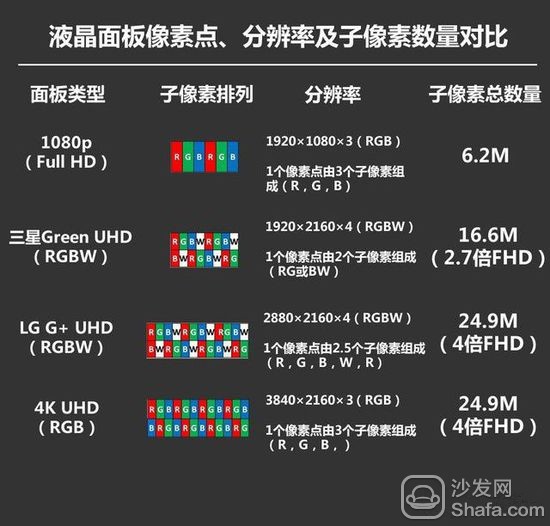
LG also has an RGBW arrangement called "G+ UHD". Two pixels have five sub-pixels, making each pixel an average of 2.5 sub-pixels. Although its physical resolution is 2880×2160, it is slightly lower than the traditional 4K UHD panel, but its number of sub-pixels is the same as RGB 4K, and the actual resolution is naturally not inferior. The two RGBW panel technologies mentioned above can make the screen have a higher brightness, lower power consumption, and reduce production costs, more suitable for product promotion.
LG WRGB+Sharp new generation four-color technology
True 4K LG WRGB Four Colors
The WRGB four-color technology mentioned below makes the LG OLED organic television panel unique. This technique simply changes the number of sub-pixels made of pixels from three to four, and there is no case of reducing the resolution. Ultra-clear OLED TVs using WRGB four-color technology change the sub-pixels of each pixel to white (W), red (R), green (G), and blue (B) while maintaining a physical resolution of 3840×2160. Four. Not only enhances the brightness of the picture, reduces power consumption, but at the same time does not affect the clarity of the picture. And the total number of sub-pixels has also increased to 3840×2160×4. However, this four-color panel has relatively high technical requirements and the cost is difficult to control, making it only applicable to high-end models. It is very difficult to promote it.
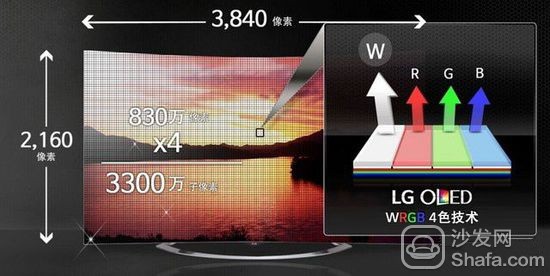
Sharp 4K comparable to 4K
Finally, Sharp's RGBY four-color technology is based on the original yellow, red, green, and blue primary colors. The color of the screen is more full and the brightness is high. However, this technology only applies to Full HD TVs, so there is no dispute between true and false 4K. Sharp's new-generation four-color technology and sub-pixel segmentation driving engine can provide higher definition and achieve a clear picture close to 4K. Due to the physiological characteristics of the human eye, the sensitivity to the visual contrast of green and yellow is relatively high. On the contrary, it is less sensitive to the visual contrast of blue and red. The new generation of four-color technology uses green and yellow to express the brightness information, and will The green and yellow colors are spaced apart so that two times of luminance information in the horizontal direction of the previous pixel is achieved in the horizontal direction, that is, twice the sharpness.

In the method of raising the resolution of the liquid crystal television in the vertical direction, the Sharp LCD panel uses a driving method that divides each pixel up and down to display different brightness. Sharp's new-generation four-color technology is based on the split-drive engine, The thin film transistors are independently controlled so that each pixel independently displays two image signals. Therefore, two independent brightness information can also be displayed in the vertical direction.
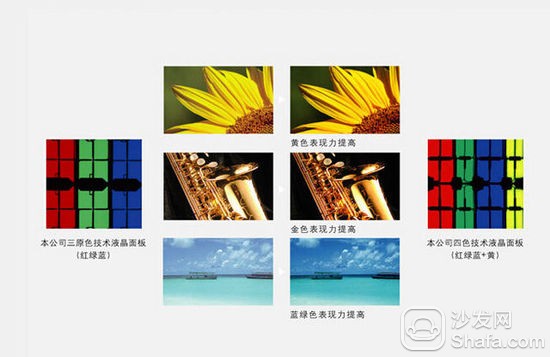
Summary: Four-color technology from the perspective of sub-pixels, significantly enhance the brightness and color of the screen, and can effectively save energy and extend the life of TV panels. For RGBW technology, applied to 4K panels, it does have a certain loss of sharpness, but in exchange for a low price and excellent brightness, overall it is still very value. Although WRGB technology for OLED makes the picture very good, the high cost does not make it difficult to promote. Sharp's new-generation four-color technology, in the absence of a 4K film source, creates a clear and beautiful picture. We should not rely solely on true and false 4K to judge the quality of a TV. Brightness, color, and power consumption are also important.


Strictly speaking, the real 4K TV should have three conditions: First, the TV screen must be 4K; Second, the TV should configure the HDMI2.0 interface, can receive and download 4K resources; third, 4K TV must also There are 4K decoder chips. For the HDMI2.0 interface and 4K decoder chip, its classification is simple, consumers are more easily distinguished. But for the screen, various manufacturers have different standards and names, and consumers often do not know exactly which is the real 4K.

4K has four times 1080P resolution
For how to identify serious fake 4K screens, many people in the industry have given a very convenient way, that is, look for RGBW four-color screen is a pseudo 4K. This statement itself is no problem, but many people do not understand the type of four-color technology, mistakenly consider RGBW four-color as a four-color system, and then use all four-color screens as 4K. In fact, RGBW is just a kind of four-color, and different manufacturers have defined different specifications of RGBW four-color panels. Therefore, it would not be feasible to use four-color technology as a criterion for judging pseudo 4K. So what are the four-color technology, and what four-color technology is pseudo 4K?
To make further distinctions, we must know exactly what four-color technology is. We usually discuss the clarity of television, which is measured by the resolution, that is, the number of pixels. However, many people do not know that each pixel consists of several sub-pixels. Each pixel of a traditional RGB television is composed of three kinds of sub-pixels: Red, Green, and Blue. The three primary colors of the optical spectrum display various colors through different proportions. The so-called four-color technology is to add one type of sub-pixel to the TV based on RGB, that is, four sub-pixels. Most of the four colors are based on red (R), green (G), and blue (B), and white (W) is added. Sharp is particularly yellow.

RGBW vs. RGB
If an added sub-pixel and the original three sub-pixels form a pixel together, the overall number of pixels is constant, and the 4K resolution can not only have rich details, but also can significantly increase the screen brightness. However, four sub-pixels form one pixel together, which increases the technical difficulty and also increases the production cost. For the 4K Chaoqing, whose price is high, this high cost change is very unfavorable for promotion.

RGBW four-color technology panel
In order to control costs and improve the brightness of the screen, some manufacturers have to sacrifice costs properly. While increasing white sub-pixels, the number of sub-pixels that make up a complete pixel is reduced. For example, originally composed of 3 sub-pixels constitutes a pixel, which is now changed to 2 or 2.5 sub-pixels, and the color is displayed by the color proportions of the 2 or 2.5 sub-pixels. Less than three sub-pixels cannot display rich colors, so its display also requires the cooperation between adjacent pixels. The fineness of the final picture will surely be discounted to a certain extent, and it will not be able to achieve true 4K results.
Speaking so much of the theory, though, has generally explained the relationship between four-color technology and 4K. However, if it is not combined with an example, it would be difficult to understand. Below, the author will analyze it according to the mainstream four-color technology classification.
Pseudo 4K RGBW four-color high-brightness and energy-saving
Pseudo 4K RGBW four colors
In fact, there are two very confusing names in the four-color technology, namely RGBW and WRGB. RGBW 4K panel is a type that Samsung, LGD and other manufacturers have introduced, and it is a pseudo 4K. And WRGB is the unique technology of LG OLED TV, it is true 4K. We are talking about RGBW four-color 4K technology below.

Four-color 4K panel
Two well-known Korean corporate brands launched two RGBW solutions. A scheme launched by Samsung is called "Green UHD," and each pixel consists of two sub-pixels (RG or BW). According to its calculation method, since two sub-pixels can constitute one pixel, the resolution can reach 3840×2160. But if the RGBW is one pixel unit, its resolution is only 1920×2160. And the total number of sub-pixels is only 1920×2160×4, and the total number of sub-pixels of RGB 4K is 3840×2160×3.

RGBW vs. RGB
LG also has an RGBW arrangement called "G+ UHD". Two pixels have five sub-pixels, making each pixel an average of 2.5 sub-pixels. Although its physical resolution is 2880×2160, it is slightly lower than the traditional 4K UHD panel, but its number of sub-pixels is the same as RGB 4K, and the actual resolution is naturally not inferior. The two RGBW panel technologies mentioned above can make the screen have a higher brightness, lower power consumption, and reduce production costs, more suitable for product promotion.
LG WRGB+Sharp new generation four-color technology
True 4K LG WRGB Four Colors
The WRGB four-color technology mentioned below makes the LG OLED organic television panel unique. This technique simply changes the number of sub-pixels made of pixels from three to four, and there is no case of reducing the resolution. Ultra-clear OLED TVs using WRGB four-color technology change the sub-pixels of each pixel to white (W), red (R), green (G), and blue (B) while maintaining a physical resolution of 3840×2160. Four. Not only enhances the brightness of the picture, reduces power consumption, but at the same time does not affect the clarity of the picture. And the total number of sub-pixels has also increased to 3840×2160×4. However, this four-color panel has relatively high technical requirements and the cost is difficult to control, making it only applicable to high-end models. It is very difficult to promote it.

WRGB technology analysis
Sharp 4K comparable to 4K
Finally, Sharp's RGBY four-color technology is based on the original yellow, red, green, and blue primary colors. The color of the screen is more full and the brightness is high. However, this technology only applies to Full HD TVs, so there is no dispute between true and false 4K. Sharp's new-generation four-color technology and sub-pixel segmentation driving engine can provide higher definition and achieve a clear picture close to 4K. Due to the physiological characteristics of the human eye, the sensitivity to the visual contrast of green and yellow is relatively high. On the contrary, it is less sensitive to the visual contrast of blue and red. The new generation of four-color technology uses green and yellow to express the brightness information, and will The green and yellow colors are spaced apart so that two times of luminance information in the horizontal direction of the previous pixel is achieved in the horizontal direction, that is, twice the sharpness.

Sharp's new generation of four-color technology
In the method of raising the resolution of the liquid crystal television in the vertical direction, the Sharp LCD panel uses a driving method that divides each pixel up and down to display different brightness. Sharp's new-generation four-color technology is based on the split-drive engine, The thin film transistors are independently controlled so that each pixel independently displays two image signals. Therefore, two independent brightness information can also be displayed in the vertical direction.

Sharp's next-generation four-color image with 4K quality
Summary: Four-color technology from the perspective of sub-pixels, significantly enhance the brightness and color of the screen, and can effectively save energy and extend the life of TV panels. For RGBW technology, applied to 4K panels, it does have a certain loss of sharpness, but in exchange for a low price and excellent brightness, overall it is still very value. Although WRGB technology for OLED makes the picture very good, the high cost does not make it difficult to promote. Sharp's new-generation four-color technology, in the absence of a 4K film source, creates a clear and beautiful picture. We should not rely solely on true and false 4K to judge the quality of a TV. Brightness, color, and power consumption are also important.
Recommended installation sofa butler Download: http://app.shafa.com/
